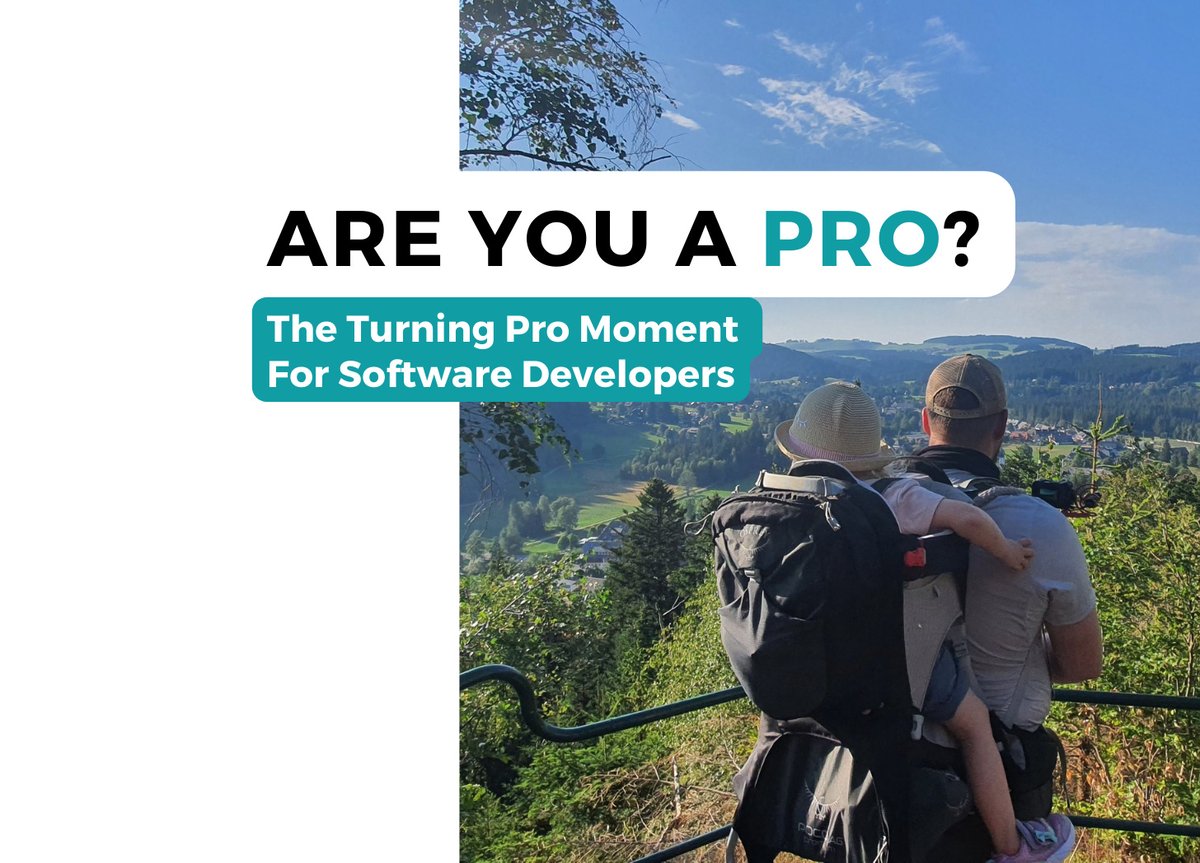The moment of turning pro is a watershed in one's career—a transition from treating one's craft as an optional endeavor to embracing it with the seriousness and discipline befitting a professional.
👉 Learn at the end of the article why being an Enthusiast doesn’t mean being a Pro.
In software development, the concept of "turning pro," articulated by Steven Pressfield in "The War of Art1," has profound implications. The moment of turning pro is a watershed in one's career—a transition from treating one's craft as an optional endeavor to embracing it with the seriousness and discipline befitting a professional. This extends beyond just coding skills; it involves a comprehensive shift in mindset where overcoming Resistance—procrastination, distractions, or self-doubt—becomes paramount.

The Turning Pro Moment for Developers
It's not just about building features rapidly but about building them right, sustainably, and with a vision of long-term maintainability.- Adrian
Turning pro in software development is closely aligned with adopting mature practices for continuous software delivery. It means assuming full responsibility for every line of code you write and ensuring it meets high-quality standards. This responsibility manifests in rigorous code reviews, meticulous testing, and a commitment to programming principles. It's not just about building features rapidly but about building them right, sustainably, and with a vision of long-term maintainability.
The Commitment To Learning
Continuous learning isn't just a perk; it's a necessity.- Adrian
Yet, the cornerstone of this professional evolution is an unwavering commitment to learning. In an ever-changing field like software development, continuous learning isn't just a perk; it's a necessity. This constant cycle of learning, applying, and iterating might be challenging, but it also instills confidence and equips one to take on greater responsibilities over time.
When you turn pro, you're not just adopting a set of skills; you're laying down a foundation for perpetual growth. This foundation is strengthened each time you learn something new, whether it's a programming paradigm, a tool, or a soft skill like effective communication.
Takeaways–What helps you turn pro?
Turn Pro in Learning
Just as you would "turn pro" in your coding practices, extend that professional attitude to your learning goals. Set aside dedicated time for learning, treat it with seriousness, and make it non-negotiable. This could mean having a learning roadmap, just as you would have a project roadmap.
Make Learning a Habit
Consistency is the key to overcoming Resistance. Integrate learning into your daily or weekly routine so that it becomes a habit rather than an activity you need to muster the willpower for. Use techniques like time-blocking or the Pomodoro Technique to manage your time efficiently.
Stay Accountable
Resistance thrives in isolation. Share your learning goals with peers, mentors, or social media followers. Regularly update them on your progress. The accountability will create an external force that helps you overcome the inertia.
Chunk It Down
Big learning goals can feel overwhelming and feed Resistance. Break them down into smaller, manageable tasks or milestones. Celebrate each small win to build momentum.
Embrace Discomfort
Learning new things is often uncomfortable. Recognize that discomfort is a sign of growth, not a signal to retreat. Facing the discomfort head-on is a way to disarm Resistance.
Remove Distractions
Resistance often takes the form of distractions. Create a focused learning environment by removing or minimizing interruptions. This might mean turning off notifications, using website blockers, or finding a quiet space to concentrate.
Reflect and Adapt
Set aside time to reflect on what you’ve learned and how you’ve applied it. Use this insight to adapt your learning strategy, tackle new challenges, or revisit foundational concepts that need reinforcement.
Use What You Learn
The best way to solidify new knowledge is to apply it. Incorporate new languages, tools, or methodologies into your projects immediately. This not only overcomes Resistance but also provides immediate value from your learning efforts.
Prioritize
Not all learning is equally important. Prioritize based on your career goals, upcoming projects, or gaps in your skill set. Focusing on what’s most important, you can maintain direction and motivation, making it easier to push through Resistance.
Be Kind to Yourself
There will be days when Resistance wins, and that's okay. The key is not to let one lapse turn into a pattern. Forgive yourself and get back on track as soon as possible.
By consistently applying these principles, you train yourself to approach learning with professionalism, discipline, and dedication as you do your work. Over time, this "turning pro" in your learning will make it increasingly difficult for Resistance to hold you back.
My Personal “Turning Pro” Moment
In reality, I was, for most of my “professional life,” an Amateur.-
From a young age, I was passionate about technology. Before I even reached the age of 10, I had begun exploring computers, and it wasn't long before I delved into programming as a hobby. There were periods when my enthusiasm to learn and experiment knew no bounds. People often commented on my talent, likely because they didn't fully grasp the intricacies of what I was doing at the time.
But I wasn’t consistent.
Since then, I have been an enthusiast, working “professionally” and making it my craft. I thought so for many years. In reality, I was, for most of my “professional life,” an Amateur. I did all the stuff because I liked it so much. And when I disliked it, I stopped and did something very different, sometimes for weeks. This continued even when I got into a leadership role. I wasn’t acting based on discipline; I was acting because of unstable enthusiasm.
And then I turned Pro.
For me, becoming pro kicked in when I took over more and more responsibilities as an employer, entrepreneur, husband, and father. It wasn’t working anymore to base everything on being an enthusiast.
Step by step, I understood that it’s me, myself, who is standing in my way to actually progress. I found reasons to procrastinate or essential things to look at, like the news app, instead of listening to an audiobook about a vital business topic I must solve. I was postponing so many things to tomorrow, and those never got finished. Tasks stacked up and became problems; task problems became mental problems.
The realization that I am actually standing still most of the time in my life, and my own inner Resistance holding me back, then brought me to realize that I am only an Amateur. I am not following through; I am playing safe.
I was enthusiastic but not dedicated.
I started to force myself out of bed, and I became humbled, which made me think less of myself. But the most important thing that led to the “Turning Pro Moment,” as Steven Pressfield would describe it, was to expose me, my shortcomings, and the problems of my colleagues, family, and later the public.
I accepted to become a disciplined learner and viewed myself as someone who knows less than expected from someone like me. I realized that you overrate yourself as an Amateur.
Once I was on this path, everything got clear: my goals, my responsibilities, and my wishes.
👉 And never again did resistance stop me from being a Professional Craftsman and Father.
Conclusion
In sum, “turning pro” is a multi-faceted commitment. It's a vow to confront and defeat Resistance, adopt mature and responsible software delivery practices, and engage in a lifelong learning journey. By taking this triad of commitments seriously, you not only elevate your own craft but also contribute more effectively to the collective goal of building robust, scalable, and impactful software solutions.
PS: A heartfelt thank you to my incredible wife, Jennifer, whose unwavering support has been my guiding light on this transformative journey. ❤️
Have a great day!
Adrian


